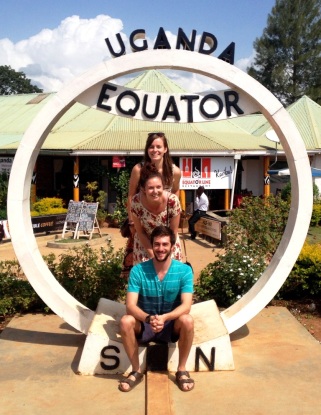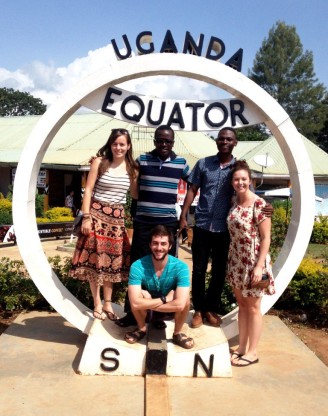July 11th 2015
When I say the center of the earth of course I don’t mean the scorching hot, inaccessible, molten core of the planet. Rather I mean the topographic center – the halfway point between the North and the South Poles. In other words, the equator.
Kampala sits about one degree above the equator, which explains its tropical weather and the lack of seasons. There are actually only ten countries that the equator runs through, as 79% of the others places at zero degrees latitude are in the ocean. So the fact that the division between the Northern and Southern hemispheres is only an hour’s drive from Kampala is pretty cool. Obviously we had to experience it for ourselves, so today we took a field trip to the center of the earth.
In Uganda the equator is marked by a giant white spherical sculpture off the side of the highway. A line runs across the road showing where one hemisphere ends and the other begins. A few feet on either side of the line there are wide basins set up, with one also straddling the line. The purpose of these basins are to show how water spins clockwise on one side of the line, and counterclockwise on the other. To demonstrate this, a local man filled the basins with water and then placed a flower in the center. As the water drained through the hole in the bottom of the basin the flower twirled accordingly. After demonstrating this phenomenon in the basins on either side of the line, he filled the one directly on the equator. Unlike with the other two basins, when he placed the flower in it the water drained out, but the flower remained still. Yup, definitely on the equator. There was only the different of a few meters between the basins, but gravity worked differently in each one. Science!
After hemisphere hopping and snapping the above pictures, our co-worker took us to his village a few kilometers away. After several minutes on a bumpy dirt road, we arrived at a lovely brick house which we soon learned was where he grew up. His mother – a school teacher and mother of ten – came out to greet us. After introductions were made our co-worker and his mother proceeded to show us around the complex, which turned out to be far more inspiring than your average house tour.
First, our co-worker and his mother showed us the livestock. Behind the house and the various adjoining mud buildings there were pens full of pigs, ducks, chickens, and a dog. They explained that the latter was for security purposes. There was also a stall for cows, but they were out grazing in the fields. After that they took us through their extensive gardens. In the space of about fifty meters they were growing sweet potatoes, corn, chili peppers, coffee, cassava, beans, five different species of bananas, and avocado, orange, passion fruit and mango trees. There was even a neem tree that they explained was used to cure colds, and a tree with leaves whose sandpaper-like texture made them ideal for scrubbing pots.
It didn’t take us long to realize that we’d stumbled into every sustainability or IDS students’ dream. We couldn’t help but be awed. Not only was there an incredible variety of plants, but the small farm was clearly being masterfully managed. Different types of crops were planted side by side to enrich the soil, and all the fruits had been collected so there were barely any rotting on the ground. Even more impressively, our co-worker’s mother told us that the household rarely has to buy food, since they grow enough and enough varieties to sustain themselves. She explained how they would save enough to eat, and then sell the rest. Since her children are all grown up and she is the head of the local school, she had hired a few workers to help with the weeding and harvesting.
Not only was the small household completely self-sufficient, but they let nothing go to waste. For example, behind the house there were two huge metal drums used to collect water during the rainy season. Moreover, the long grass that was growing sporadically is dried and used to make brooms. There was even a biogas system, where cow dung was processed to produce gas. Afterwards the manure was used to fertilize the gardens, or even to enforce the walls of the older houses. That’s a pretty impressive list of uses for cow poop if you ask me.
After our brief tour I found it hard to imagine a more sustainable, self-sufficient, or well managed plot of land.* To top it all off, after the tour we were ushered inside to eat a huge lunch made of food grown right outside the door. The only things purchased were the rice and the pineapple for dessert. It was all delicious of course, and we were left with full bellies and food for thought (sorry, I had to).
But our lessons of the day didn’t end with agriculture. As we waited for lunch we learned that our co-worker and our boss are actually cousins. Moreover, the other intern who had come with us on the trip is said co-worker’s nephew, making our co-worker’s mom his grandmother. This discovery started us off down a whole line of questioning into the nature of Ugandan families. Through about an hour of listening, we learned that they are complicated. Here’s why:**
Firstly, being an extremely patriarchal society, it’s common for men in Uganda to have multiple wives. This means that most people have many half-siblings, multiple grandmothers, etc. Furthermore, women seem to have anywhere from four to twelve children each. So one man can have upwards of thirty or forty children. There are several reasons for such large families: partly for security in case children die young, partly to have many hands to help out, and partly because contraceptives aren’t always widely available. Furthermore, even when contraceptives are available many Ugandans are very Catholic and therefore choose not to use them. Also, men often discourage women from taking them, or women will have had a bad experience with one type and therefore swear off all of them. Either way, the result is many children.
But I’m getting off topic. The point is, the large nature of Ugandan families means that people are raised with a strong sense of community (going back to the idea of Ubuntu discussed briefly in my last post). And as if a typical Ugandan’s family tree isn’t complicated enough, there is then the matter of clans. During our pre-lunch conversation I learned that Uganda has 52 clans which have existed for centuries. Each clan has a totem – for example our co-worker’s clan is represented by the mud fish. You may never eat the animal that is your totem (so you better hope it’s not a chicken or cow). You also can’t marry someone from your clan since they are probably related to you by blood. Even though these rules aren’t written down, they are common knowledge and seem to carry the weight of any law.
The clans also make up kingdoms. I’m pretty sure Uganda has five kingdoms, the largest of which is called Buganda. In fact, Uganda was named after the Buganda kingdom. Buganda has eighteen counties, one of which includes Kampala. Bugandans speak Luganda, which is the most common language in Kampala. However, different regions have different languages, making traveling within the country very confusing.
Naturally, each kingdom also has a king. The king of Buganda lives in Kampala, and his palace is near the city center.*** The king is not a political figure – rather he represents the epitome of Buganda culture. However, he arguably has more sway over the people here than the president does, and therefore his power is not insignificant. This is despite the fact that the kingdoms were only recently reinstated, after being abolished by the president who preceded Idi Amin. Yet despite its 30+ year hiatus, Buganda seems to have stayed incredibly strong. This is in part due to its rigorous structure, whereby there is a representative of the king in every community. Even when the British arrived to colonize the area, they were impressed by the incredibly structured ruling system. In fact, they were so impressed that they didn’t even attempt to dismantle it, and rather sought to manipulate it from the inside.
Finally, one of the most interesting things I learned about Buganda is the way they choose the heir to the throne. Our co-worker explained that the heir can be any of the king’s children, and the eldest child is not allowed to take the throne. Furthermore, the heir is chosen in secret. In fact, the heir’s birth is never even announced. This is because once he is chosen he is sent to be raised by a family who the king trusts. He us raised as an average Ugandan, and isn’t told that he is heir to the throne until the king dies. Pretty exciting right? The purpose of this secrecy and false identity is for the king to be raised like a commoner, so he can understand his people. That way when he has to rule them he’ll know firsthand about their problems. Sounds like a pretty good system to me!
Alright. I’ll stop there with the history lesson (partly because it’s getting late here, but mostly because I’ve run out of facts). I hope you’ve enjoyed my summary of what I learned today as much as I enjoyed learning it. Thanks to today’s lessons in history and agriculture I’ll be going to bed saturated and exhausted – and not only because I spent the day in two hemispheres!
____________________________________________
*In my limited experience, the only thing that wasn’t amazingly managed was the building where the cooking was done. Smoke billowed out from charcoal fires, which is known to be a key source of respiratory diseases in the so called Global South.
**As usual, please note that my knowledge is limited so the following account might not be entirely accurate. This is just my understanding of Ugandan culture from what I learned today.
***One of his daughters is actually on Jeremy’s swim team – small world.









